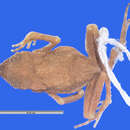en
names in breadcrumbs


Bufo caeruleostictus és una espècie d'amfibi que viu a l'Equador.
Es troba amenaçada d'extinció per la pèrdua del seu hàbitat natural.
Bufo caeruleostictus és una espècie d'amfibi que viu a l'Equador.
Es troba amenaçada d'extinció per la pèrdua del seu hàbitat natural.
Rhaebo caeruleostictus is a species of toad in the family Bufonidae. It is endemic to Ecuador and occurs along the lower western slope of the Cordillera Occidental at elevations of 40–2,000 m (130–6,560 ft) asl.[1][2][3][4] The specific name caeruleostictus, from Latin caeruleus (=blue) and Greek stiktos (spotted), refers to the bluish colour pattern of this species.[3][5] Accordingly, common name blue-spotted toad has been coined for it.[1][2][4]
Males measure 76–81 mm (3.0–3.2 in) and females 72–92 mm (2.8–3.6 in) in snout–vent length.[3][4][5] The Dorsum and sides have blueish-blackish vermiculations on orangish background (this coloration is assumed to be aposematic). The tympanum is not visible.[5] The parotoid glands are large.[4]
Its natural habitats are tropical moist forests and cloud forests.[1] It is a terrestrial species that breeds in riparian habitats.[5]
It is a rare species that is threatened by habitat loss caused by agricultural expansion, logging, and wood plantations.[1] It has not been seen since 1997, and it might be extinct.[5]
{{cite journal}}: CS1 maint: multiple names: authors list (link) Rhaebo caeruleostictus is a species of toad in the family Bufonidae. It is endemic to Ecuador and occurs along the lower western slope of the Cordillera Occidental at elevations of 40–2,000 m (130–6,560 ft) asl. The specific name caeruleostictus, from Latin caeruleus (=blue) and Greek stiktos (spotted), refers to the bluish colour pattern of this species. Accordingly, common name blue-spotted toad has been coined for it.
Rhaebo caeruleostictus[1][2][3] es una especie de anfibio anuro de la familia Bufonidae.
Esta especie es endémica de la vertiente occidental de la Cordillera Occidental en Ecuador. Habita entre los 40 y 2000 m de altitud.[4]
Rhaebo caeruleostictus Rhaebo generoko animalia da. Anfibioen barruko Bufonidae familian sailkatuta dago, Anura ordenan.
Rhaebo caeruleostictus est une espèce d'amphibiens de la famille des Bufonidae[1].
Cette espèce est endémique du versant Ouest de la cordillère Occidentale en Équateur[1]. Elle se rencontre entre 40 et 2 000 m d'altitude.
Rhaebo caeruleostictus est une espèce d'amphibiens de la famille des Bufonidae.
Bufo caeruleostictus là một loài cóc thuộc họ Bufonidae. Đây là loài đặc hữu của Ecuador. Môi trường sống tự nhiên của chúng là rừng ẩm vùng đất thấp nhiệt đới hoặc cận nhiệt đới, vùng núi ẩm nhiệt đới hoặc cận nhiệt đới, và sông ngòi. Chúng hiện đang bị đe dọa vì mất nơi sống.
Phương tiện liên quan tới Rhaebo caeruleostictus tại Wikimedia Commons
Bufo caeruleostictus là một loài cóc thuộc họ Bufonidae. Đây là loài đặc hữu của Ecuador. Môi trường sống tự nhiên của chúng là rừng ẩm vùng đất thấp nhiệt đới hoặc cận nhiệt đới, vùng núi ẩm nhiệt đới hoặc cận nhiệt đới, và sông ngòi. Chúng hiện đang bị đe dọa vì mất nơi sống.